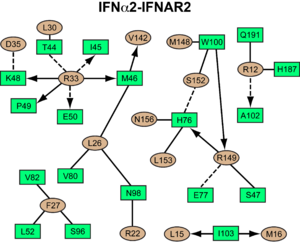Journal:Cell:1
From Proteopedia
(Difference between revisions)

| Line 29: | Line 29: | ||
One of the more controversial aspects of cytokine signaling is whether receptor binding is sufficient to generate activity, or if it has to be accompanied by structural perturbations. The type I interferon signaling complex is a rare example of a cytokine receptor complex were the structures of all the components making up the biologically active complex were determined to high resolution in both their free and bound forms. <scene name='User:David_Canner/Workbench3/Morph_1/6'>A comparison</scene> of the unbound NMR structure with the ternary complex structure of interferon shows a small expansion during complex formation. | One of the more controversial aspects of cytokine signaling is whether receptor binding is sufficient to generate activity, or if it has to be accompanied by structural perturbations. The type I interferon signaling complex is a rare example of a cytokine receptor complex were the structures of all the components making up the biologically active complex were determined to high resolution in both their free and bound forms. <scene name='User:David_Canner/Workbench3/Morph_1/6'>A comparison</scene> of the unbound NMR structure with the ternary complex structure of interferon shows a small expansion during complex formation. | ||
| - | Both IFNAR1 and IFNAR2, however, undergo significant domain movements upon binding. Using the D1 domain as anchor, a <scene name='User:David_Canner/Workbench3/Morph_2/10'>clear outwards movement of the D2 domain</scene> of IFNAR2 upon binding, on a scale of 6-12 Å, is observed (comparison of the unbound receptor ([[1n6u]]) with the binary IFNa2-IFNAR2 complex). | + | Both IFNAR1 and IFNAR2, however, undergo significant domain movements upon binding. Using the D1 domain as anchor, a <scene name='User:David_Canner/Workbench3/Morph_2/10'>clear outwards movement of the D2 domain</scene> of IFNAR2 upon binding, on a scale of 6-12 Å, is observed (comparison of the unbound receptor ([[1n6u]]) with the binary IFNa2-IFNAR2 complex). The superimposition of the IFNa2-IFNAR2 binary complex with IFN-IFNAR2 in the ternary complexes <scene name='User:David_Canner/Workbench3/Morph3/7'>reveals an additional domain movement</scene> of 6-9 Å, and even between the ternary IFNa and IFNw complexes a movement of 3-5 Å is observed. The D2 domain is engaged in crystal contacts in all three structures, and it remains an open question if the conformational changes in IFNAR2 are physiologically relevant. Still, these movements could change the proximity or orientation of the ICDs and associated Jaks within the cell. |
The low-affinity receptor chain, IFNAR1, also <scene name='User:David_Canner/Workbench3/Morph_4/4'>undergoes major conformational changes</scene> upon ligand binding. When using D1 as anchor, D3 is moving inwards (toward the ligand) by ~15 Å. This would generate an even larger movement of the transmembrane proximal D4 domain and the transmembrane helix. The conformational changes in IFNAR1 are necessary to form the full spectrum of interactions with the IFN ligand, and to form a stable signaling complex that is able to instigate downstream signaling. Contrary to D3, D4 seems to be highly flexible (even more than D2 of IFNAR2). One may suggest that the conformational changes in IFNAR1 by itself will be responsible for a reduced binding affinity of IFNAR1 and may slow down the rate of ligand association to IFNAR1 directly from solution. The proposed mechanism would result in a much tighter control on interferon signaling, as random events of receptor proximity will not be able to overcome the activation energy needed for receptor structural rearrangements, which require specific ligand binding. The overall mechanism of activation may be even more complex, if indeed the D2 domain of IFNAR2 is also moving upon ligand binding (as suggested by the structures). In this case, a <scene name='User:David_Canner/Workbench3/Morph_full/3'>concerted movement of both receptors</scene> would be required to form a fruitful reaction complex. | The low-affinity receptor chain, IFNAR1, also <scene name='User:David_Canner/Workbench3/Morph_4/4'>undergoes major conformational changes</scene> upon ligand binding. When using D1 as anchor, D3 is moving inwards (toward the ligand) by ~15 Å. This would generate an even larger movement of the transmembrane proximal D4 domain and the transmembrane helix. The conformational changes in IFNAR1 are necessary to form the full spectrum of interactions with the IFN ligand, and to form a stable signaling complex that is able to instigate downstream signaling. Contrary to D3, D4 seems to be highly flexible (even more than D2 of IFNAR2). One may suggest that the conformational changes in IFNAR1 by itself will be responsible for a reduced binding affinity of IFNAR1 and may slow down the rate of ligand association to IFNAR1 directly from solution. The proposed mechanism would result in a much tighter control on interferon signaling, as random events of receptor proximity will not be able to overcome the activation energy needed for receptor structural rearrangements, which require specific ligand binding. The overall mechanism of activation may be even more complex, if indeed the D2 domain of IFNAR2 is also moving upon ligand binding (as suggested by the structures). In this case, a <scene name='User:David_Canner/Workbench3/Morph_full/3'>concerted movement of both receptors</scene> would be required to form a fruitful reaction complex. | ||
Revision as of 09:37, 25 July 2011
| |||||||||||
- ↑ no reference
Proteopedia Page Contributors and Editors (what is this?)
Christoph Thomas, Jaime Prilusky, Joel L. Sussman, Michal Harel, Alexander Berchansky
This page complements a publication in scientific journals and is one of the Proteopedia's Interactive 3D Complement pages. For aditional details please see I3DC.



